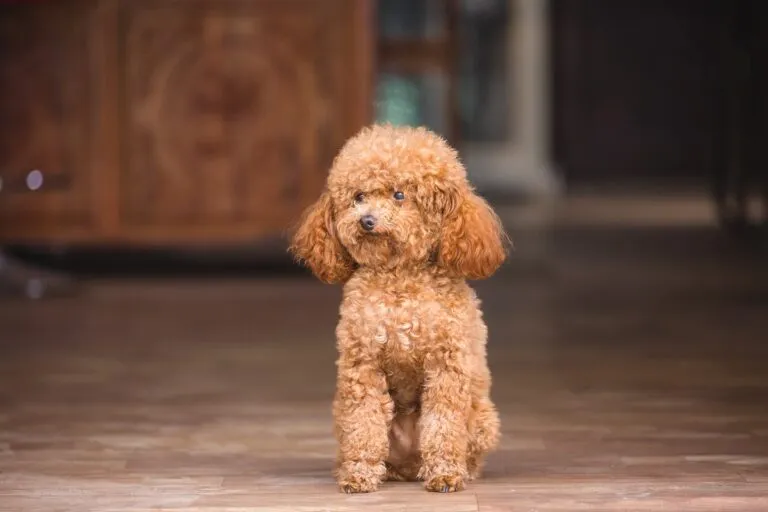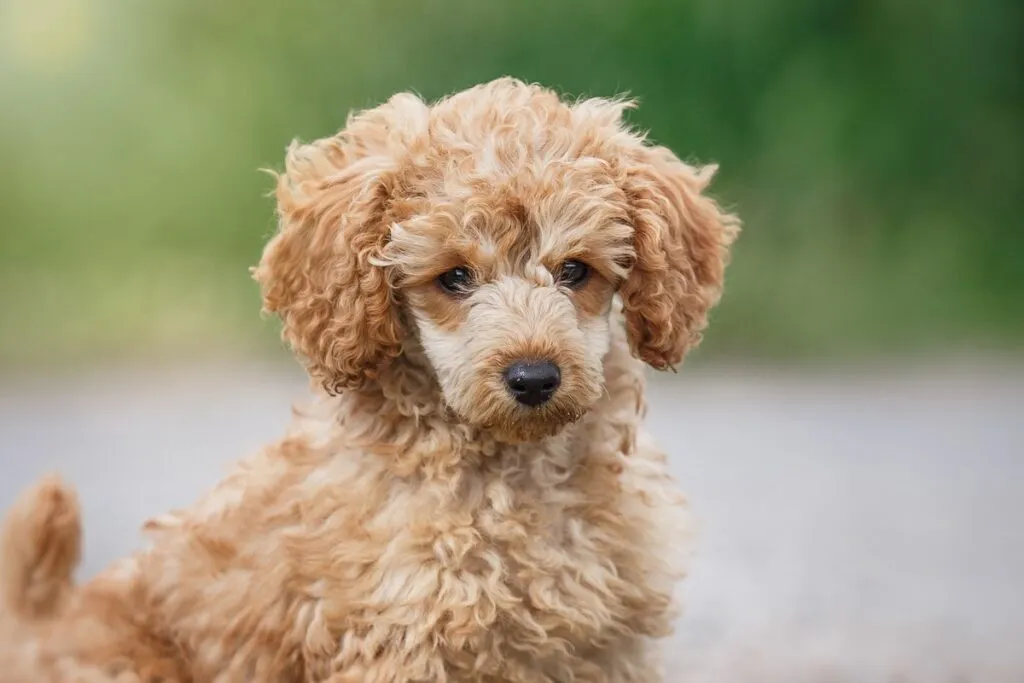Medium Size Poodle
The Toy Poodle is the smallest representative of the Poodle breed. It's considered a friendly family dog that can be nervous and fearful in unfamiliar situations. Some animal welfare advocates see this Poodle variety, due to its extremely small size, as meeting the criteria for overbred characteristics.

© pascalkphoto / stock.adobe.com
The Toy Poodle is certainly a topic of debate: some animal welfare advocates believe that this variety of poodle meets the criteria for breeding that causes suffering.
The Toy Poodle reaches a shoulder height of 24 to 28 centimetres. According to breed standards, a deviation of one centimetre is tolerated. The weight for both sexes is approximately two to four kilograms.
The build of the Toy Poodle is delicate, muscular and nearly square. Like its larger Poodle counterparts, it has a soft, curly fur that comes in black, white, brown, silver, fawn, harlequin and black-and-tan. Characteristics of this four-legged friend include its narrow muzzle, slightly slanting almond-shaped eyes, and heavily furred floppy ears.
Many dog experts classify the Toy Poodle as an overbred breed. This canine is even smaller than the Miniature form of the Poodle, which is expressed by the prefix “Toy”. To breed ever-smaller Poodles, exceptionally small, frail animals are often mated, which can lead to numerous health problems in the offspring. However, the Toy Poodle is officially recognised as one of four Poodle forms by the international kennel club Fédération Cynologique Internationale (FCI). Eleven member countries of the federation objected to this recognition. The other sizes, by the way, are called Standard Poodle, Miniature Poodle, and Dwarf Poodle.
 © annaav / stock.adobe.com
© annaav / stock.adobe.com
The Toy Poodle might be small and cute in appearance, but it’s still a full-fledged dog. The mini is especially known for its high intelligence, trainability, and strong desire to please its owners. Therefore, it’s relatively easy to train and can even be owned by beginners.
Thanks to its friendly, peace-loving nature, the Toy Poodle makes a fine family dog. However, particularly small children should be reminded that, despite its adorable looks, it is not a stuffed toy but a sentient being with individual needs.
These dogs are very affectionate and loyal. They prefer to be with their owners at all times. If left alone for too long, Toy Poodles can bark persistently. Additionally, they may respond to loud noises with frightened barking. In general, the minis often act insecurely in unfamiliar situations. Thus, a certain nervousness and anxiety are part of the behavioural description of this little dog.
To stay physically and mentally fit, the Toy Poodle needs a lot of exercise. It enjoys accompanying its family on walks and light hikes. Small obedience training or retrieval exercises as well as scent work provide variety to its daily walks. At home, the tiny dog can be well entertained with puzzle toys.
A Toy Poodle should be allowed to go outside for at least two hours a day. Many of these Poodles love water and enjoy splashing around in lakes and streams. After all, their ancestors were hunting dogs used for retrieving shot waterfowl. The lively, athletic Toy Poodle can also be enthusiastic about Agility—however, the obstacles must be adjusted to its small size. They can also have a lot of fun with their owners during Dog Dancing or Obedience Training.
The curly hair of the Toy Poodle doesn’t shed but continues to grow. To prevent tangles and skin infections, its coat must be brushed daily. About every eight weeks, a visit to a dog grooming salon is due: the little one gets a professional haircut.
Popular styles include the fashionable teddy cut, which enhances the natural contours of the little dog. A simple short haircut is especially practical, allowing the mini to romp outside without plant parts getting stuck in its fur. Before appearances at dog shows, Toy Poodles often receive a special show grooming.
Besides coat care, regular checks of claws, teeth, eyes, and ears are important. Due to its narrow muzzle, the teeth of the Toy Poodle are closely spaced, which can promote the development of dental diseases.
Moreover, the minis are prone to ear infections because of their hairy floppy ears. These can be very painful and therefore need to be treated by a vet as soon as possible.
Due to the overbreeding issue, some Toy Poodles have degenerated eyeballs. If the tear ducts are blocked or even completely missing, it leads to increased tear flow, which also requires special care.
High-quality food with a high meat content is the ideal diet for this little bundle of energy. If you want to feed your Toy Poodle dry food, make sure that the kibble is adjusted to its small size.
Due to the problematic breeding, which aims for dwarfism in this dog, numerous hereditary diseases are observed in Toy Poodles. They normally do not appear in their larger Poodle relatives in this form or frequency.
For example, kneecap dislocation, or a dislocating kneecap, can cause problems. Another condition affecting the musculoskeletal system is Legg-Calvé-Perthes Syndrome: It leads to pain in the hip joint and lameness. A constriction of the trachea, technically called tracheal collapse, can lead to breathing difficulties.
Typical eye diseases that occur in Toy Poodles are Cataracts (grey star) and Glaucoma (green star). Some also suffer from a condition known as Entropium: this is an inwardly rolled eyelid that can impair vision. Despite the long list of potential hereditary diseases associated with extreme dwarfing, Toy Poodles tend to reach a fairly old age. They have a life expectancy of 15 to 17 years.
Poodles were originally hunting dogs, responsible for retrieving shot game from the water. In the 19th century, these friendly, affectionate quadrupeds were increasingly kept as companion and lap dogs. Around this time, the breed also began to be developed in various sizes. Initially, only Standard and Miniature Poodles were differentiated. Later, the Dwarf Poodle was added, from which the particularly small Toy Poodle eventually emerged. The breed Poodle is believed to originate from France. French breeders also pushed for the recognition of the Toy Poodle against the concerns of other FCI member countries.
Due to the numerous hereditary diseases that can occur in Toy Poodles, it’s particularly important to buy a puppy from a reputable breeder. The price usually ranges between €1,500 and €2,500—sometimes even more.
Fashionable dogs like the Toy Poodle are sometimes offered as “deals without papers.” However, these “bargain bin puppies” should be avoided. These animals often come from unscrupulous breeders who place no value on the health of their dogs or on animal welfare.
Frequently, the parent animals are sick, and the puppies are poorly socialised. Inbreeding is not uncommon in cruel mass breeding facilities. All this can lead to health problems and behavioural issues, resulting in high costs for veterinary treatment or the support of a dog trainer.
Underneath the curly fur of the tiny Toy Poodle lies an intelligent, people-oriented dog. It wants to move around a lot and use its smart little head.
Due to the overbreeding problem, puppies of this size should only be purchased from reputable breeders who care more about the welfare of their charges than quick profit.
| Noteworthy: | Toy Poodle is a friendly little dog, however, is criticised due to the overbreeding issue |
| Character: | Affectionate, intelligent, lively, agile, insecure |
| Withers Height: | Males and females: 25-28 cm |
| Weight: | Males and females: 2-4 kg |
| Fur: | Curly, without undercoat, permitted colours: Black, White, Brown, Silver, Fawn, Harlequin and Black-and-Tan. |
| Coat Care: | Brush several times a week, get a haircut about every 8 weeks at the dog salon, no shedding |
| Exercise: | High demand for activity, enjoys dog sports, loves water |
| Beginner Dog: | Yes |
| Barking: | Barks when lonely and / or scared |
| Life Expectancy: | 15-17 years |
| Typical Diseases: | Cataracts, Glaucoma, Entropium, Patellar Luxation, Tracheal Collapse, Epilepsy |
| Price: | €1,500-€2,500 |
| FCI Group: | Group 9: Companion and Toy Dogs Section 2: Poodles |
| Origin: | France |
Here are some purchase proposals curated by the zooplus editorial team
The products featured have been carefully selected by our editorial staff and are available at the zooplus online pet shop. The selection does not constitute advertising for the mentioned brands.
Fans of the Bearded Collie agree that those who aren't familiar with this dog breed simply have to get acquainted with it. And those who have experienced how a Bearded Collie bolts across meadows with its flowing fur, how it rolls around full of energy and joy and how it attentively and observantly takes into account its owners wishes become simply addicted to this original dog breed and its unique charm.
The Goldendoodle isn't a breed, but a pairing between Golden Retrievers and Medium or Standard Poodles. Marketed as a low-maintenance dog for allergy sufferers, this hybrid is enjoying increasing popularity amongst dog lovers, similar to the Labradoodle.